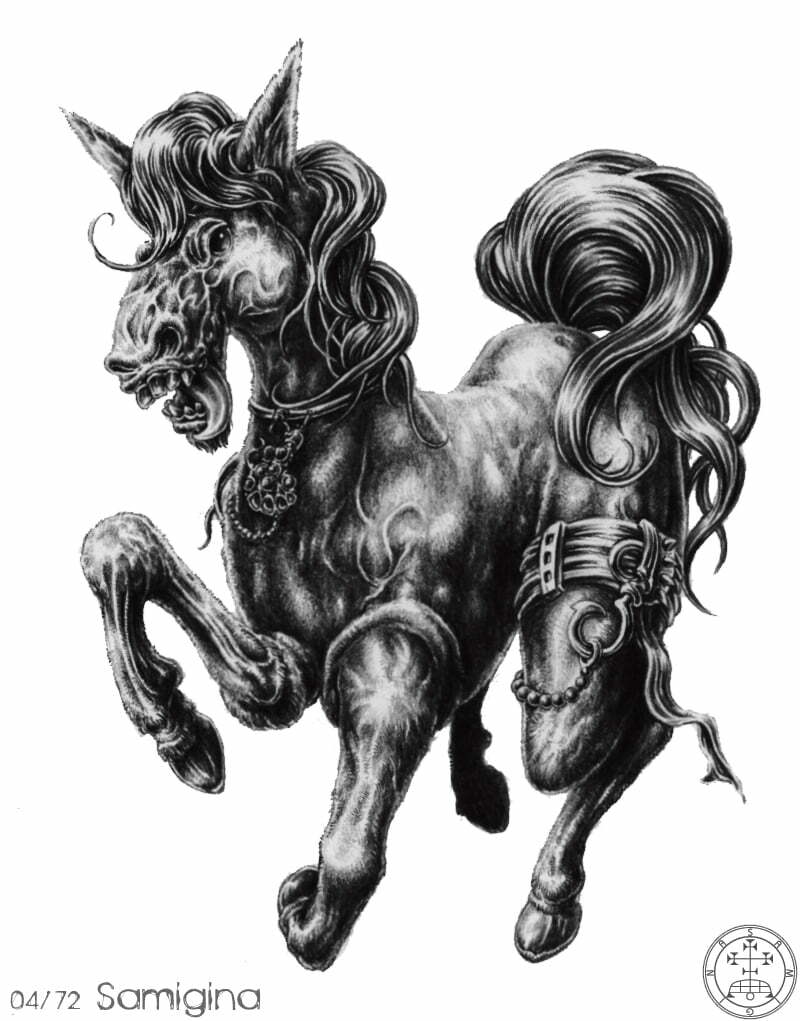Demon, Gamigin

Designed By Aaron Loeb, Erik Mona, Chris Pramas, and Robert J. Schwalb
Originally from The Book of Fiends
Few cynical students of the occult are surprised upon learning of Gamigin, demonic patron to the power of the universal constants, death and taxes. When a chaotic evil creature dies, its soul manifests in the Abyss, where it either quickly learns to protect itself or is consumed by ravenous hordes of demons. From the moment it arrives to the moment of its destruction, the soul’s activities and whereabouts are monitored by Gamigin, the calculating demon prince known as the Soulcounter.
Gamigin weighs the value of each soul against archaic formulae, occasionally announcing an ‘imbalance’ and dispatching a cadre of skullduggers to collect the debt owed to the Abyss. These servitors retrieve the soul and bring it to Gamigins lair on the Jagged Tor of Final Reckoning, where it is fed into a boiling pit of magical tar known as the Last Morass. The process completely destroys the soul. While Gamigin seems to derive some satisfaction from the power transfer, the true beneficiary is the Abyss itself, which grows stronger with each consumed soul. Some claim that Gamigin is not truly a demon prince, but rather a puppet ‘the Soulcounter didn’t dominate a layer of the Abyss so much as the Abyss dominated him.
The studious Gamigin wears the robes of a scholar and bears a volume known as the Spirit Ledger at all times. His sole weapon is an oversized brush, which he employs to paint disastrous symbols upon the air in front of him when threatened by enemies. At his command, the brush can transform into a scythe. Gamigin has the head of a horse crowned by an impressive array of antlers.
The Jagged Tor of Final Reckoning is little more than a massive stone citadel situated upon a mile-tall mesa formed of knotty, mutant flesh. Noxious clouds poisonous even to demons hug the layers floor far below. Rumors of Qlippoth infesting this occluded realm have never been substantiated. Gamigin’s citadel features endless hallways open for several stories. Huge, meticulously arranged bookcases line the walls. Records of every soul ever to pass into the Abyss, as well as the fate of those souls, can be found within these cases, but Gamigin seldom allows strangers to peruse his records. His books show the current location of every creature in the Abyss, and he is well aware of the value of that information. Seventeen chambers contain treasure and material wealth granted to Gamigin in exchange for information on countless demons and mortal souls. He does not revel in this wealth, but he does take enormous pride in it and would prefer to see its growth continue.
Gamigin’s followers on the Material Plane consist largely of liches or spellcasters well on the path to lichdom. Such beings have little use for the type of deals demon princes tend to offer. As undead creatures, their souls remain locked between the mortal world and the afterlife’ safe, in a sense, from the attentions of demons. They approach Gamigin as equals, for he knows more about how to protect one’s soul than perhaps anyone in the multiverse. The Soulcounter’s cult is much more refined than the vile religion of Orcus, one of the most powerful demon princes in the Abyss. The rivalry between Gamigin and Orcus goes back to the rise of the demons, when each battled for greater influence over undeath. Gamigin lost that fight, ceding (for the most part) the administration of undeath on the Material Plane to his hated foe. Should Orcus show signs of weakness, however, Gamigin is more than willing to assume that coveted role.
OBEDIENCE
In an effort to better understand the process of death and the mindset of the undead, thaumaturges in service to the Soulcounter engage in a daily ritual few outsiders find watchable. Using specially prepared pins, oils, and unguents, the thaumaturge mortifies a one-inch-square portion of his own flesh (usually, but not always, on some part of his body normally covered by clothing). The process takes several days to complete (though it need only be done once), but eventually the dead flesh begins to rot, becoming infested with maggots and parasites. During the obedience ritual, the thaumaturge removes a maggot from his own dead flesh and pushes it into his eyesocket, allowing the tiny creature to wriggle around next to the eyeball. By doing so, he believes he gains insight into the world beyond the mortal realm. After a few minutes of exploring the thaumaturge’s eye cavity, the maggot melts into his interior flesh, replenishing the spellcaster’s daily complement of spells.

 Buy me a coffee
Buy me a coffee